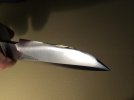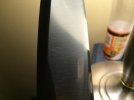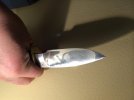- Joined
- Oct 13, 2013
- Messages
- 168
So using the mousepad/sandpaper method for sharpening convex edges what grits do I use? I know it probably depends on how dull but what sandpapers do I need? 400, 600, 800, 1000 & 2000?
Also if I understand this correctly, I lay the knife flat when sharpening right and the cushion of the mouse pad will keep it right with just a little pressure instead of trying to hold the knife at a very low angle?
I've watched videos and did a lot of reading but am slow I guess and I wanted to confirm.
Also if I understand this correctly, I lay the knife flat when sharpening right and the cushion of the mouse pad will keep it right with just a little pressure instead of trying to hold the knife at a very low angle?
I've watched videos and did a lot of reading but am slow I guess and I wanted to confirm.




